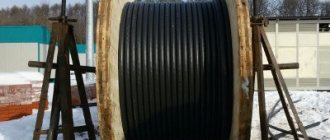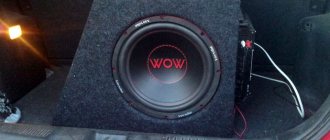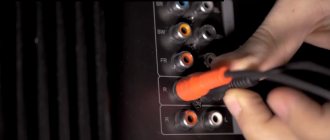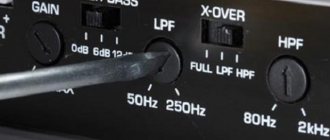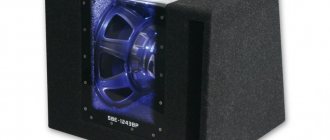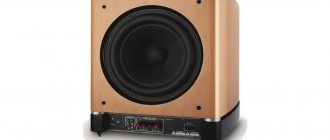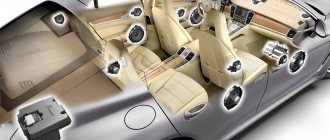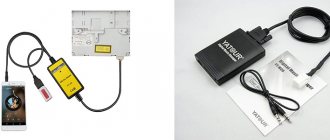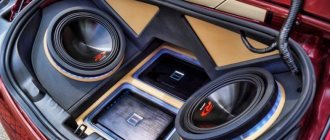Manufacturers of speaker systems recommend warming up new devices, that is, starting listening after several hours of operation, as if idling. Pink noise is best suited for warming up - a special signal containing all frequencies of the auditory range, in which the loudest sounds are bass ones, and the higher the frequency, the lower the volume.
In this case, the load on the mid/bass speakers and tweeter is correctly distributed. But listening to such a “concert”, and even for several hours, is very unpleasant, so you can use regular music, but “noisier”.
Difficult
The sound perceived by a person is the movement of air, and it is also generated by movement: the surface of the wall, if you hear voices from the next room, or the diffusers of the speaker speakers when listening to a CD. So in the columns the same thing happens as in other moving mechanisms - their components “grind in”, that is, even the smallest surface irregularities, which require additional energy during operation, are smoothed out by friction.
And it is recommended not to use cars at high speeds until they have accumulated several thousand kilometers, and new shoes can cause trouble until they wear out. And we must not forget that a lot of elastic materials are used in speakers. For example, hangers and centering washers are made from them.
Many parts are glued together, and the glue does not just lie between them - it penetrates into their surface layers, forming a new structure. First it hardens, but then its elasticity must be restored.
This is what happens during the initial operation of the speaker. As a result of movement, materials heat up, their properties change, and these changes are preserved, as if remembered. Speakers with speakers with metal diffusers need to be heated longer - metals have a small heat capacity, they cool faster, so the layers of glue and rubber of the suspension to which they are attached warm up more slowly.
Namely, the suspension is one of the main sources of nonlinear distortions in sound, and if its characteristics have not yet returned to normal, then the direct dependence of the diffuser displacement on the force applied to it may be disrupted. This will lead to the appearance of harmonics that interfere with the correct reproduction, and just noise.
Warming up the speakers
Instructions from speaker system manufacturers recommend warming up all new devices and starting listening to music only after the speakers have been idling for several hours:
- Pink noise is best suited for warming up - this is a special signal that contains all frequencies in the auditory range, the loudest sounds in it are bass ones, and the higher the frequency of the sounds, the lower their volume
- This music for warming up the acoustics correctly distributes the load on the mid/bass speakers
- However, listening to such a “concert” for a long time is very unpleasant, so either turn on the speakers and go for a walk, or use regular music, only “noisier”
What's happening at this time
The sound that the human ear perceives is the movement of air; it is also generated by movement:
- When you hear, for example, a conversation from the next room, or the movement of speaker diffusers in the speakers while listening to music
- It turns out that the same processes occur in the columns as inside any other moving mechanisms, the components gradually “grind in”, friction smooths out even the smallest surface irregularities, which require additional energy during their operation
- New cars are also not recommended for use at maximum speeds until their mileage reaches several thousand kilometers, or, for example, new shoes cause some discomfort until they wear out
- In addition, do not forget that many different elastic materials are used in the construction of speakers.
- For example, they are used to make centering washers and hangers
- Many parts are held together with glue, this glue is not just located between the parts - it penetrates into the surface layers and forms a new unique structure
- First the structure hardens, but then its elasticity needs to be restored
- This process occurs during the initial operation of the speaker system.
- As a result of work, all materials heat up, their properties change, then these changes are partially preserved, one might say remembered
- Speakers (see Yamaha acoustic speakers: review of models) in which the speakers have metal diffusers need to be heated longer - after all, metals have a small heat capacity, so they cool faster, and the layers of glue and rubber bands to which the rubber bands are attached warm up more slowly
- It is the suspension that is the main source of nonlinear distortions in sound, and when its characteristics do not return to normal, then the direct dependence of the displacement of the diffuser itself on the force applied to it may be disrupted
- Which leads to the appearance of harmonics that disrupt the correct reproduction and the appearance of noise
- These distortions are easily distinguishable by ear, which is why the sound of new speakers is often harsh and unpleasant
- There is no need to force the speakers to play at full power immediately - this will lead to overheating and damage to the speakers
- There are also devices that cannot do without such a procedure before each listening (for example, tube sound amplifiers) - everything largely depends on the materials
Just
The essence of the process is elementary and can be easily demonstrated. Take a piece of cardboard or a celluloid strip and try to bend it. She resists. But bend it back and forth a couple of times and it will literally dangle along the bend line.
The speakers are an electromechanical system. And the diffuser has an elastic suspension. And it is some combination of the same cardboard, plastic, fabric, rubber...
But the “elasticity” of the suspension of the new speakers is akin to that new cardboard.
What is acoustic warming up?
Warming up is a forced process of mechanical “softening” of the elastic suspension.
Warming up the speakers means warming up all the elastic elements (suspensions, centering washers, etc.). The lower-frequency the speaker, the more critical it is to warm-up.
Naturally, after this, the diffuser suspension will be more “responsive” to the slightest pressure from the magnetic field of the speaker coil - hence the higher volume and better dynamics and purity of sound.
After warming up, the sharpness in the high frequencies (if there was one) will go away and the quality (not quantity) of the low frequencies will improve.
Distortion is clearly noticeable by ear, so the sound of new speakers is often harsh and unpleasant. You should not force them to play at full volume - this can lead to overheating and damage to the speakers.
Almost all manufacturers of speaker systems strongly recommend that their consumers warm up new speakers, that is, begin full listening to the speakers at least after several hours of continuous operation at idle.
Some acoustics manufacturers warm up the speakers at the factory, but in any case it is useful to review the operating instructions, where the manufacturer gives his recommendations. It also happens that you cannot do without this procedure before each audition - it all depends on the properties of the materials.
To warm up the speakers, it is necessary to use special measuring generators that generate the necessary signals or recordings (mp3, flac, wav) of these signals.
Pink noise is best suited for warming up - a special signal containing all frequencies of the auditory range, in which the loudest sounds are bass ones, and the higher the frequency, the lower the volume.
In this case, the load is most correctly distributed between the mid/bass speakers and the high-frequency speaker (tweeter).
What affects acoustics
Firstly, everyone knows that the sound of acoustics is influenced by the material from which the suspension is made, what mass the suspension has, the stiffness of the diffuser and these properties (of our acoustic system), in the particular case of the speaker, are expressed in numerical values that actually characterize sound purity. So:
- These are the so-called Thiel Small parameters, which even characterize the flexibility of the suspension, the returning forces of the diffuser, and they also take into account many other parameters
- Let's give a simple abstract example - take and buy two rubber inflatable balls
- You immediately inflate one and let it hang in the corner of the room for a couple of days, in an inflated state.
- Deflate after a couple of days, take a second balloon and try to inflate one, then the other
- To feel the difference, inflate with your lips, the one that hung in your room for a couple of days, delighting with its presence, now inflates more easily and willingly
- This is an independent test that shows that the properties of the rubber (as well as the suspension) of the speakers will change over time
- In addition, their Till Small parameters will change over time.
- These changes occur most strongly during the first 300 hours of listening to music.
- It turns out that these are not “myths and legends” of audiophiles, but elementary physics
- Test two - go to a headphone store, this is also a speaker, just not a car one (what difference does it make, the rules are the same for all speakers)
- First, listen to the headphones on the stand, which have already been played for several days, then ask them to take new ones out of the box and listen too
- You will feel the difference
- Warming up is the exit to the normal operating mode of the speakers (the properties will not change in the future, and will correspond to those indicated on the packaging by a bona fide manufacturer)
- Warming up can be called the forced process of “softening” the elastic suspension. It turns out that warming up is bringing it into the optimal “operating mode”
- It is only important to know how to warm it up so as not to damage the equipment, the price of negligence will be high
Are there exceptions to which speakers need to be heated and which ones do not? Let's be clear now:
- It doesn’t matter at all from what price segment dynamics (cheap or expensive) The structure in all of them is the same - a moving diffuser with an elastic suspension
- We only note that for expensive speaker models, the manufacturer usually carries out this procedure independently before selling
- How and to what extent warming up will affect your acoustics is almost impossible to predict!
- We simply force the speaker to reach a constant maximum power in the shortest possible time; acoustic music will help here
- The parameters may differ greatly from the sound of a new speaker, for the better or for the worse.
- Most, as a rule, note an improvement in the sound of the low-frequency range, which becomes noticeably denser
- The main thing is that the ear-piercing sibilants (hissing, ringing notes in the high frequency composition) disappear.
- Of course, everyone has their own hearing, and everyone hears what they are capable of hearing.
Where can I find tracks/music to warm up my speakers?
There are several solutions for warming up the speakers; you can download the following tracks:
- IsoTek Full System Enhancer & Rejuvenation Disc - contains three discs: for small acoustics, for large acoustics (including subwoofer), quick update.
- Tara Labs cascade noise burn-in disc is an advanced material for warming up audio-electronic components and audio cables, including cables with devices such as batteries or filter networks. The authors claim that it is better than its analogues thanks to its main feature - a sequence of rectangular signals.
“Warming up” headphones - mythology
We were inspired to create this material by questions from some users asked in l/s, as well as in the comments to a recent publication about choosing headphones. Various resources on the network and a large number of people on relevant forums also disseminate information about the “benefits” of “warming up” electrodynamic emitters. By “warming up,” the authors mean the continuous use of acoustic systems and headphones for many hours in order to change their physical properties and, accordingly, the sound, often using the so-called. pink and white noise.
For those who need quick answers to the question “how to warm up speakers or headphones?”, as well as “how will warming up affect sound quality?” I will give simple and quick answers: “not at all” and “will never or almost never affect.” To make it even more convincing, we will cite statements from employees of manufacturing companies and experts in the field of sound.
Analysis of the information and some comments from experts allow Newton to say with confidence after being hit by an apple that “warming up” the headphones is a useless exercise. But still, so that all people can understand what we are talking about, let’s start with the myth itself. The following will be an argument in favor of the conclusions drawn.
Myth
The following information is the author’s invention and has no real prototypes.
As “everyone” knows, “warming up” speaker systems and headphones has been known since antiquity. One of the authors who lived in one of the Greek city policies (his name, as usual, history has not preserved), wrote the following about the “warming up”:
Having bought telephones for your ears, which are called headphones, Or large speakers with spiritualized sound. Don’t you dare break the immutable law that was given by the great Apollo - Don’t listen to the sound that filled the cold of Hades!
Don’t listen to the fools that they shout about earthly laws, Warm up the speaker quickly to cleanse it of cold filth! Only the gods are able to fill the membrane with pure energy that passes through the pink noise for hours. By warming up a great goal you will achieve!
Modern followers of an unknown ancient author present the following arguments in favor of warming up the speakers:
- “All mechanical systems need to be “broken in” like a new car” - especially typical for specialists in the field of car audio;
- “Warming up allows the speaker to acquire permanent mechanical properties”;
- “Warming ensures that the elasticity of the acoustic emitter membrane increases so much that it radically changes the sound”;
- “To warm up, you need to use pink noise, which, when played for a long time, changes the properties “correctly”;
- “The “warm-up theory” has been proven by modern physical science; changes after warm-up are reflected in the frequency range of the acoustics and the frequency response”;
- “Any acoustics must be “warmed up” for 50 to 200 hours, and in some cases for a longer time.”
Reality
The “theory” of “warming up” dynamic loudspeakers, and even more so drivers of other types, does not stand up to criticism, both from the point of view of practical application and from the point of view of materials science.
Only a number of manufacturers of low-frequency acoustics include warm-up recommendations in their manuals, indicating a time of 50 to 100 hours, but the latter does not apply to headphones. It is also unknown whether this is a tribute to tradition or has a technical basis. Moreover, it is not clear why these manufacturers do not “warm up” during the pre-sale preparation process. Almost unequivocal counterarguments testifying against the “theory” of warming up, and especially headphones, are the following:
First
– materials used to create dynamic and other emitters do not require additional increases in elasticity. Density, elasticity and other properties responsible for the electromechanical characteristics of acoustics during the “warming up” process do not undergo significant changes;
Second
– the design of drivers and headphones as a whole does not imply additional pre-operational preparation such as “warming up”, since the engineers designing it create the device ready for immediate use;
Third
– theoretically possible changes in the properties of materials that occur during “warm-up” (long-term use) are not actually reflected in the sound and do not in any way affect the quality of the product, since in the vast majority of cases they are within the permissible error of the device parameters or are not recognized by the equipment at all , nor blind tests.
At the moment, there is not a single scientific work, there is not a single pure, from a scientific point of view, experiment that confirms the opinion of the supporters of the “heating theory”.
The cautious statements of some headphone manufacturers regarding “warm-up” are demonstrative. For the most part, they are very contradictory, which, with a high degree of probability, is due to the reluctance to offend the feelings of those audiophiles who are groundlessly convinced of the truth of the positive impact of this manipulation on sound quality.
Beyerdynamic Lead Designer Günther Weidmann
who was involved in the creation of the legendary Tesla (Beyerdynamic T1) evasively answered the question about warming up, saying the following:
“We do not recommend any specific period for warming up. Some audiophiles don't warm up their headphones at all, while others are happy with a few hours of warming up."
Representatives of MEElectronics also carefully answered the question about warming up:
Warming up is not necessary to enjoy the MEElectronics headphones. However, many people report improved sound after warming up. Regarding the warm-up duration, we note again - it is not necessary to warm up the headphones, but if you decide to do this, then, according to most enthusiasts, this time should be 50 hours. If you do not notice any changes after warming up, this is normal.
Other representatives of large brands more categorically state that “warming up” is not needed, there is no data on its effect, and no one releases specifications for warming up.
Scott Houston
from the German company Sennheiser, when asked about the need and time for warming up the speakers, stated the following:
We do not have any specifications regarding warm-up time. This is not necessary, and the headphones can play music perfectly at any volume - right out of the box.
Shure sound engineer Yuri Shulman
, who expressed the following opinion regarding warming up on the company’s official blog:
“The need for warming up is more a myth than a fact. It's a matter of perception. Shure headphones sound the same throughout the entire period of use.”
Shure conducted the following test: several pairs of E1 headphones, produced in 1997, were re-tested after several years of operation and their current technical parameters were determined. Bottom line: all characteristics remained unchanged and fully corresponded to those that were present during the first use.
From the above, it becomes clear that “warming up” does not have any significant effect on the characteristics of the headphones or their sound quality, and therefore this procedure is practically useless.
We can only partly agree that the warming up procedure can lead to changes in the frequency response, as a rule, in woofers with a so-called “paper” membrane. The last statement is based on the experiment of circuit engineer Alexander Bolshakov, who in 1987 noticed a change in the lower limit of the frequency range of 1.5 Hz on Soviet 75GD1 speakers after an 80-hour “warm-up” using an LFO, but did not notice any changes in the sound auditorily emitter.
The engineer himself questions the purity of the above experiment due to possible errors in the equipment, as well as differences in conditions (temperature, humidity).
The opinion of the author of the material is not the official position of the PULT.RU company, which maintains neutrality in matters of “warming up”, based on insufficient research into the issue in acoustics and solid state physics.
